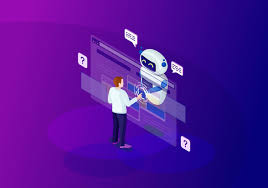Chatbots have become an integral part of modern business operations, offering enhanced customer engagement, streamlined workflows, and round-the-clock support. Developing a chatbot, however, requires robust tools and technologies. This is where chatbot development platforms come into play. These platforms provide the necessary infrastructure, tools, and resources to create, deploy, and manage chatbots efficiently. This article delves into the world of chatbot development platforms, exploring their features, benefits, popular options, and key considerations for choosing the right platform.
What is a Chatbot Development Platform?
A chatbot development platform is a comprehensive software environment that provides the tools, frameworks, and resources necessary for creating, deploying, and managing chatbots. These platforms support various aspects of chatbot development, including natural language processing (NLP), machine learning (ML), integration with other systems, and user interface design.
Key Features of Chatbot Development Platforms
- Natural Language Processing (NLP): Enables the chatbot to understand and interpret human language.
- Machine Learning (ML): Allows the chatbot to learn from interactions and improve over time.
- Integration Capabilities: Supports integration with various systems such as CRM, ERP, CMS, and social media platforms.
- Multi-Channel Deployment: Facilitates deployment across multiple channels like websites, mobile apps, messaging apps, and voice assistants.
- User Interface Design: Provides tools for designing the chatbot’s conversational flows and user interactions.
- Analytics and Reporting: Offers insights into chatbot performance, user interactions, and areas for improvement.
- Security and Compliance: Ensures data privacy and compliance with industry regulations.
Benefits of Using a Chatbot Development Platform
1. Accelerated Development
Chatbot development platforms offer pre-built templates, components, and frameworks that speed up the development process, enabling businesses to launch chatbots quickly.
2. Cost-Effectiveness
Using a platform reduces the need for extensive custom development, lowering the overall cost of chatbot implementation and maintenance.
3. Scalability
These platforms support scalability, allowing businesses to handle increased user interactions and expand the chatbot’s capabilities as needed.
4. Ease of Integration
Seamless integration with existing systems ensures that the chatbot can access and utilize real-time data, providing more accurate and contextually relevant responses.
5. Enhanced User Experience
Advanced NLP and ML capabilities enable chatbots to understand and respond to user queries more effectively, enhancing the overall user experience.
6. Continuous Improvement
Analytics and reporting tools provide insights into user interactions, enabling continuous improvement of the chatbot’s performance and capabilities.
Popular Chatbot Development Platforms
1. Google Dialogflow
Google Dialogflow is a powerful platform that uses Google’s advanced NLP and ML technologies to create conversational agents. It supports voice and text-based interactions and integrates seamlessly with Google Assistant, Amazon Alexa, and other platforms.
Key Features:
- Rich NLP capabilities
- Integration with Google Cloud
- Multi-channel support
- Context management
- Pre-built agent templates
2. Microsoft Bot Framework
The Microsoft Bot Framework is a comprehensive platform for building and connecting intelligent bots. It supports various programming languages and integrates with Azure Cognitive Services for enhanced NLP and AI capabilities.
Key Features:
- Multi-channel deployment
- Integration with Azure services
- Advanced AI and NLP
- SDKs for multiple languages
- Bot management tools
3. IBM Watson Assistant
IBM Watson Assistant leverages IBM’s Watson AI to create sophisticated chatbots. It offers robust NLP, ML, and integration capabilities, making it suitable for enterprise-level applications.
Key Features:
- Powerful NLP and ML
- Integration with IBM Cloud
- Multi-channel support
- Analytics and reporting
- Pre-built industry solutions
4. Rasa
Rasa is an open-source platform that provides tools for building, deploying, and managing contextual AI assistants. It offers flexibility and control, making it ideal for developers who prefer a more hands-on approach.
Key Features:
- Open-source framework
- Customizable NLP and ML
- Contextual conversation handling
- Integration with various systems
- Community support
5. Amazon Lex
Amazon Lex is a service for building conversational interfaces using voice and text. It uses the same deep learning technologies that power Amazon Alexa, providing high-quality speech recognition and language understanding.
Key Features:
- Integration with AWS services
- High-quality NLP and speech recognition
- Multi-channel deployment
- Secure and scalable
- Built-in support for Lambda functions
Key Considerations for Choosing a Chatbot Development Platform
1. Business Requirements
Assess your business needs and objectives. Consider the specific use cases, target audience, and desired functionalities of the chatbot.
2. NLP and AI Capabilities
Evaluate the platform’s NLP and AI capabilities to ensure it can understand and respond to user queries accurately and effectively.
3. Integration
Ensure the platform supports integration with your existing systems and third-party applications to provide a seamless user experience.
4. Ease of Use
Consider the platform’s ease of use, including the availability of pre-built templates, drag-and-drop interfaces, and comprehensive documentation.
5. Scalability
Choose a platform that can scale with your business, handling increased user interactions and expanding its capabilities as needed.
6. Security and Compliance
Ensure the platform complies with industry regulations and provides robust security measures to protect sensitive data.
7. Cost
Evaluate the platform’s pricing model, including any additional costs for advanced features, integrations, and support services.
8. Support and Community
Consider the availability of support resources, including customer support, training materials, and a developer community.
Future Trends in Chatbot Development Platforms
1. Enhanced AI and NLP
Future platforms will offer more advanced AI and NLP capabilities, enabling chatbots to understand and respond to complex queries with greater accuracy.
2. Voice and Multimodal Interactions
Platforms will increasingly support voice and multimodal interactions, allowing users to engage with chatbots using a combination of text, voice, and visual inputs.
3. Proactive and Predictive Capabilities
Chatbots will become more proactive and predictive, anticipating user needs and providing assistance before it is requested.
4. Integration with Emerging Technologies
Chatbot platforms will integrate with emerging technologies like augmented reality (AR), virtual reality (VR), and the Internet of Things (IoT) to provide more immersive and interactive experiences.
5. Personalization and Customization
Future platforms will offer more personalization and customization options, allowing businesses to tailor chatbots to their specific needs and user preferences.
Conclusion
Chatbot development platforms are revolutionizing the way businesses create and deploy intelligent automation solutions. By providing the necessary tools, frameworks, and resources, these platforms enable businesses to build sophisticated chatbots that enhance customer engagement, streamline operations, and drive growth. When choosing a chatbot development platform, it is essential to consider factors such as NLP and AI capabilities, integration, ease of use, scalability, security, cost, and support. As AI and chatbot technologies continue to evolve, the potential for chatbots to transform business operations and customer interactions is immense. By leveraging the right platform, businesses can unlock the full potential of AI chatbots and achieve their strategic objectives.










